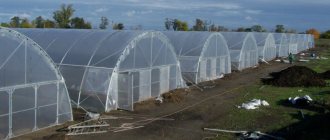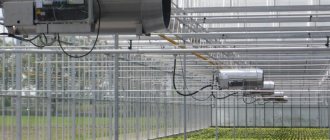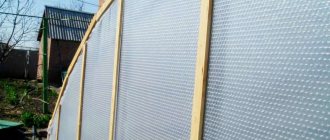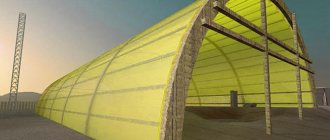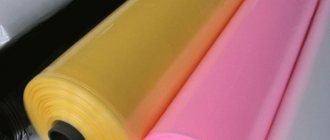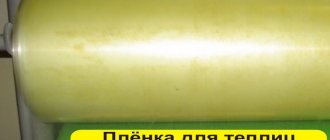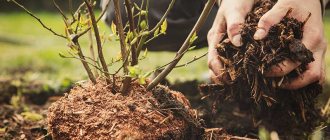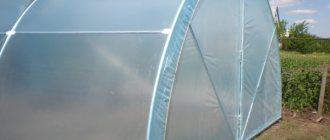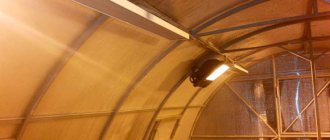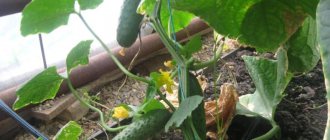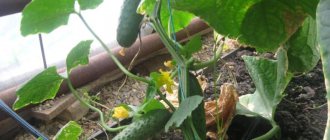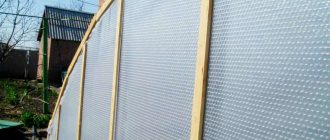Types of greenhouse film: features of choice and properties
Manufacturers produce greenhouse film in a wide range. But before purchasing covering material, you need to know in advance which film is best to use for the greenhouse. To make the right choice, compare their properties and characteristics.
Polyethylene unstabilized
Unstabilized polyethylene film for greenhouses is affordable. Most often, a sheet or sleeve with a thickness of 100-150 microns is used for greenhouses. The advantages are also light weight and a large selection in stores. It is the most popular among greenhouse growers because of its cheapness and availability.
But this film has disadvantages:
- Small thickness, due to which low thermal insulation leads to sudden temperature changes inside the greenhouse. During the day, the indicator rises sharply, at night it decreases, up to 80% of the heat is lost and condensation collects in the greenhouse under the film.
- Lack of UV filters, as a result, plants suffer from ultraviolet radiation.
- Fragility - destroyed during the 1st season (6-8 months) under the influence of the sun's rays.
Covering a greenhouse with unstabilized film is usually used to grow frost-resistant plants. After one harvest it becomes unusable.
Polyethylene film with additives
Polyethylene with special additives has improved characteristics. This film is better suited for a greenhouse installed on a personal plot. It happens:
- Stabilized - resistant to direct rays. In appearance it is similar to conventional analogues made of polyethylene (marking is on the packaging).
- Light-converting with a phosphor additive – it converts UV radiation harmful to plants into useful red and infrared radiation, which has a beneficial effect on productivity.
Advice! In order to determine whether a film for greenhouses has UV protection or not, you need to shine it with a special lamp - the light falling on the coating should turn red.
- Hydrophilic stabilized film differs from conventional polyethylene film in the absence of accumulating moisture, poor transmittance of infrared radiation, which eliminates sudden temperature changes at night and during the day, and the presence of light stabilizers that do not allow the polymer to degrade under the influence of direct rays of the sun. Hydrophilic film for greenhouses does not lose its properties over several years of operation.
Important! When using stabilized film for greenhouses, the yield increases by 10-15%.
Heat retaining
This is the best film for a greenhouse, which allows you to grow heat-loving crops. The temperature is 1-3°C higher compared to conventional analogues and is well maintained. Translucent material is characterized by:
- presence of a matte shade;
- antistatic and hydrophilic properties, reducing the amount of dust and condensation;
- transmits less UV rays and prevents the heat accumulated during the day from escaping.
Such greenhouse film has an extended service life - up to 9 months, and an increase in yield from 10 to 30%.
Air bubble
Bubble film for greenhouses is used as a covering material. The material has good heat-insulating properties. The film is suitable for winter greenhouses, since the internal cavity of the bubbles is filled with air, thereby creating reliable protection for plants at low temperatures. Damage to one mini-compartment does not impair the properties of the entire coating. The covering fabric is two-layer, but some manufacturers use polyethylene as an additional layer, placing it on the outside.
PVC film
Polyvinyl chloride is a durable film for greenhouses, characterized by elasticity, and lasts much longer - from 2-3 to 6-7 seasons. The timing directly depends on care, climatic and operating conditions. Among the features:
- good light transmittance - up to 90%;
- blocks UV radiation - up to 80%;
- low frost resistance - at -15°C the polymer is destroyed, so PVC film for greenhouses in winter should only be used with heating;
- the presence of light-transforming and stabilizing additives in the composition.
The disadvantage is the ability to attract dust, but this negative factor is compensated by simple maintenance - dirt from the surface is easily removed with water.
Reinforced
The coating of the reinforced film is made of stabilized low-density polyethylene. The reinforcing base is a cellular frame made of threads of different thicknesses of one of the following materials:
- fiberglass;
- lavsan;
- high pressure polyethylene;
- polypropylene fibers.
Reinforced film for greenhouses is durable and has high tensile strength. Cell sizes vary from 6 to 12 mm. Some manufacturers produce antistatic coatings that do not attract dust. Another variety is “breathable” greenhouse film, in which each mini-compartment is equipped with a “micro” ventilation hole that provides air access to the greenhouse plants. The service life is up to 3 years.
Advice! A coating with a density of 150 to 200 g/m2 is best suited for greenhouses. Material with lower values has low wear resistance, despite the presence of several layers.
Ethylene vinyl acetate copolymer
Ethylene vinyl acetate copolymer coating has improved properties:
- Elasticity;
- Strength;
- Good resistance to negative environmental influences and low temperatures;
- High light transmittance - up to 95%;
- Durability - from 5 to 8 years.
Covering material is available with antistatic and hydrophilic coatings. The disadvantages are high transparency and lack of scattering effect. Such greenhouse films allow ultraviolet rays to pass through and do not provide adequate protection, which causes burns on plant leaves.
Copolymer reflective
Reflective film for greenhouses has special properties, which is ideal for southern and northern regions. The light reflection effect works in two directions. Even if light transmission is reduced during the day, balance is created in the greenhouse, since the heat accumulated during the day is retained at night. The coating has high strength and can withstand sufficient loads.
Acrylic
Acrylic film for greenhouses has been used relatively recently. This fabric is a good protection for plants from low temperatures. This is a frost-resistant film for greenhouses, suitable for use in winter. The material has many advantages:
- Ability to withstand mechanical loads;
- Strength and ductility;
- Environmental cleanliness;
- Good heat transfer, due to which a favorable microclimate is formed in the greenhouse;
- Remains transparent for a long period.
The downside is the high price, but the durability of the material pays for itself. Service life reaches 10 years.
Advantages of acrylic film
For some time now, acrylic film has appeared on the market - a worthy competitor to glass. Its light transmittance ranges from 86%, which contributes to the rapid ripening of a wide variety of crops.
In addition, ultraviolet rays freely penetrate through this material. Its level of heat transfer could be compared to that of polycarbonate. Its interesting quality is its ability to pass water and air. At the same time, the heat that accumulates under the film does not erode, creating a constant temperature inside the greenhouse, at a certain external temperature.
Thanks to its characteristics, this material prevents plants from freezing and, interestingly, does not allow them to burn. Owners of their gardens or summer cottages can save a lot of time with this type of film. After all, if a greenhouse or greenhouse is covered with it, then there is no need for constant ventilation and monitoring to ensure that the plants do not become hypothermic or, conversely, do not suffer from high temperatures. In addition, the ideal conditions that are created because the named material is used make it possible to obtain twice as much yield from each plant bush, which again will please every amateur gardener or professional in this field. The latter are already well aware of the unusual qualities that acrylic has, and therefore successfully use it for the benefit of their plants.
Density, thickness and dimensions
Dense and thick film sheet for greenhouses is more resistant to negative environmental factors. If the thickness of the film for a polyethylene greenhouse is not a significant indicator of durability, then for stabilized analogues it is an important characteristic.
It is quite difficult to distinguish between greenhouse film with a thickness of 100 and 200 microns, so you need to know the weight of a linear meter:
- 100 microns weighs 0.26 kg;
- 120 microns - 0.32 kg;
- 150 microns - 0.40 kg;
- 200 microns - 0.53 kg.
Note! To make the right choice, it is important to know how many microns of film are needed for the greenhouse. The optimal thickness is 150 microns, creating a balance of strength and light transmission, regardless of the time of day.
The dimensions of the film for greenhouses should correspond as much as possible to the parameters of the frame. Before purchasing, you need to calculate how much film you will need for the greenhouse. The material is sold in rolls. Usually the canvas has the shape of a sleeve or half-sleeve, and with a width of 1.5 m, when unfolded, it turns out to be 3 m if the canvas is cut on one side. The width of films for greenhouses, depending on the type of coating and manufacturer, varies from 1.2 to 5 m. The width of films for industrial greenhouses made in Europe can reach 16 m.
Popularity of film
The use of glass for construction is gradually fading into the background - it is being replaced by film for greenhouses. Modern material is more resistant to mechanical damage, it is not so brittle and expensive. Replacing a damaged element here is faster and easier, without the need to change an entire section. But these are not all the advantages that a polymer coating can boast of:
- ensuring a real “greenhouse effect”;
- long service life of the structure;
- resistance to weather conditions, including frost, hail, gusty winds;
- better light exchange with the external environment.
The use of film allows you to regulate the level of soil moisture, which is also important for the future harvest. Vegetables need to be watered much less frequently, which results in saving water resources.
You can buy a coating based on the square footage; you should also take into account the density, which determines the degree of protection and penetration of ultraviolet radiation.
In our store we offer a wide selection of films for greenhouses, the price is set both per roll and per square meter. You can also choose the right size via the Internet using the product catalog.
Which film to choose for a greenhouse based on color?
Transparent and white films for greenhouses predominate on the market, but manufacturers also offer multi-colored coatings. Colored coatings are used to refract sunlight to change the hue, which will help improve crop yields. In cloudy weather, plants do not receive enough yellow and red spectrum, so covering material of similar shades makes up for this deficiency.
Chinese film for greenhouses, white and blue, creates daylight even at dusk. The coating allows sunlight to pass through and blocks harmful radiation. Two-layer black and white film for greenhouses is used for mulching and weed control. Placed on the beds with the light side up, which prevents overheating of the soil.
Greenhouse under film
Having decided to choose film as the main material for covering greenhouses, you should consider acceptable design options. The most optimal dimensions of the structure vary within the following limits: width - 2.4 m, height - 2.5 m, length from 6 to 7 m. If you have free time, it is not necessary to purchase a ready-made copy. Making your own greenhouse under the film is much more interesting. Experts offer 3 frame options - metal, wood and frame-based.
The metal arch is made from a pipe d 2.5-3.0 cm. The base can be old sleepers or tarred timber. Installation of a greenhouse under film includes the following steps:
- To attach the arch, holes 7-10 cm deep are prepared in the wooden base of the greenhouse.
- The arches are mounted at a distance of 1-1.5 m from each other.
- If you plan to make the base of the greenhouse metal, it is optimal to choose a corner. In this case, the structure is connected using bolts or welding.
- The ridge rail performs the function of connecting the arches from above; on the sides the structure is fixed with purlins. Like the base, the metal elements of the greenhouse are connected by welding or bolts.
Advice! When using a bolted connection, you should not drill holes in the arch, this will weaken the structure. Experts recommend first welding the brackets to the arch and attaching the purlins to them.
Making the frame of the heifer under a film of wood is a completely acceptable solution. To do this you will need:
- Select material in the form of timber with a minimum cross-section of 50/50 mm.
- Pre-treat the wooden elements of the future greenhouse with an antiseptic and dry thoroughly before starting installation work.
- The base is poured with concrete mortar or mounted from timber with a cross-section of 50/100 mm.
- Approximately 4 beams are prepared for the side walls; two beams are needed for the end surfaces.
- The timber that forms the roof is installed in proportion to the side structures. The structure of the greenhouse under the film is completed by a ridge beam.
Another option for a greenhouse is a structure assembled from frames. You can use both old items that have expired, as well as new products assembled yourself. Main stages of work:
- For frames you will need timber with a section of 30/40 mm.
- When designing frame sizes, to reduce waste, find out in advance the dimensions of the film that will be attached to them.
- The optimal size of the structure is 1.5 m wide and 1.5-1.8 m long.
- It is recommended to stretch the film in two layers.
- The prepared frames are mounted into the frame of the structure.
- The basis of the frame can be a metal corner or a wooden beam.
- Frames with film are attached to a wooden frame using nails, and those intended for ventilation are hung on hinges.
How to extend the life of film
To increase their service life, even durable covering materials require proper installation and careful handling. In addition, you need to know that you need to remove the film from the greenhouse for the winter. There are several reasons:
- If the canvas is thin, then under the pressure of snow it will sag and may tear from strong winds.
- High-strength canvas is resistant to negative influences, but there is a high probability that the wooden frame will not withstand the load created by snow.
If it is possible to take care of and remove snow in a timely manner during the winter, then the stronger and more durable canvas can not be removed from the frame, but only free the upper part so that the snow can get inside.
Pricing Policy
We are proud to announce that we are ready to provide the most reasonable price for greenhouse film, available in an assortment of thickness, width and density. We do not sell fake or counterfeit products. Our loyal prices can be explained by the following:
- Our company works directly with the manufacturer without intermediaries;
- We have a well-coordinated team of logisticians who will thoughtfully arrange the delivery of products from the workshop to our warehouses;
- We purchase polyethylene fabric on a wholesale order basis, which makes the savings real;
- We do not seek to profit from clients.
Our task is to sell quality goods and make a profit from turnover.
There is a particular rush for the purchase of such products in early spring and autumn, when summer residents and farmers everywhere install greenhouses or insulate greenhouses for the winter. We are ready to please our customers with seasonal discounts and provide high-quality products that will not harm plants and do not emit harmful odors and substances.
It makes sense to register on the portal as regular customers, so that when you shop with us every year you can receive the necessary discounts and take part in promotions and bonus programs.
Multilayering is a guarantee of quality
Multilayer technology provides for the presence of various additives and a more durable structure. These films for greenhouses have improved characteristics:
- Increased strength;
- UV blocking;
- Light scattering effect;
- Adjustment of thermal and infrared radiation;
- No condensation;
- Durability.
Typically multilayer films consist of 3-5 layers. No matter how many layers, the covering material looks uniform.
Main types of film shelters
There are several main types of greenhouse film.
Available in polyethylene
The most popular covering material. Sold in the form of canvas or sleeves of different densities. The width of such a film is on average from 1 to 3 m.
Advantages of the material:
- cheapness;
- does not change the biochemical properties of the soil;
- easy to attach;
- has low weight;
- conducts up to 90% of sunlight.
Flaws:
- even a high-density product will rarely last more than one season;
- attracts dust and dirt and is difficult to clean;
- easily destroyed by careless use, from exposure to cold air, precipitation, wind;
- does not retain heat well at night, the soil and air in the greenhouse cool down in a short time;
- even small damage spreads quickly;
- Condensation often forms on the surface, which harms plants.
You can find transparent or black products on sale. There are also other color solutions. For example, green or orange film for greenhouses.
The darker the material, the less light it transmits. In this case, a certain part of solar radiation is reflected from the colored film without reaching the plants.
Reinforced film
The reinforced product consists of polyethylene film and additional sheathing. The frame base in the form of a mesh is made of specially treated fiberglass, polypropylene or monofilament. Thin threads 0.29-0.32 mm wide form cells measuring about 1-1.2 cm.
Advantages:
- the main load in the product falls on the frame itself, so the material resists snow and rain well, and can withstand even small hail;
- seedlings under cover are stored at outside temperatures down to -5 °C;
- environmental friendliness;
- the average lifespan is 3 years, some varieties can be used for up to 5-7 years;
- damage can be repaired, for example, holes can be sealed with tape;
- high tightness;
- easy to store and transport.
Flaws:
- generally less transparent than ordinary polyethylene (transmittance about 80%);
- high price;
- During operation, it becomes cloudy, attracts dust, and because of this, it begins to transmit light less well.
High-quality reinforced film has special holes. Through them, fresh air enters the room. Also, a breathable greenhouse film prevents condensation from accumulating on the surface of the material. The properties of the product depend on what the frame is made of. Different fibers react differently to weather conditions.
Polyvinyl chloride film cover
In appearance it resembles the pale yellow material from which medical IV tubes are made. Through polyvinyl chloride, 90% of sunlight and only about 5% of ultraviolet radiation reach plants. This property resembles glass.
Advantages of PVC:
- retains heat for a long time at night, suitable for delicate plants that do not like temperature changes;
- high elasticity and strength;
- does not rustle;
- easy to clean from dirt;
- will last at least 2 seasons.
Disadvantages of the material:
- 2-3 times more expensive than regular polyethylene;
- low frost resistance;
- strongly attracts dust and becomes electrified;
- sags, needs to be tightened from time to time.
With proper use and favorable weather conditions, a PVC film shelter will last 5-7 years. The fragile material does not tolerate temperatures from -15°C and below, so in winter a greenhouse made from it must be heated.
How to cover a greenhouse with film
You need to know how to cover a greenhouse with a film with a wooden or metal frame. Work should be performed at a temperature of 10-15°C, at which the film web is stretched without overhanging or tension. To prevent rubbing, the skates and protruding corners are pre-glued with transparent tape.
The canvas is attached to the frame with self-tapping screws or nails with a wide head; the limiter can be a rubber washer, a strip or strip made of wood, polymer, or durable tape. The overlaps at the junction of the strips must be at least 15 cm; such a connection is glued with tape.
Before covering the greenhouse with film, the following frame elements must be processed:
- There should be no burrs, irregularities or sharp edges on wooden parts. Defects are processed with sandpaper.
- There is no rust on metal rods and welding areas.
The choice of which film is best to cover the greenhouse depends on climatic and operating conditions and the characteristics of the covering material.
How to make a greenhouse from film with your own hands
Building a greenhouse with your own hands is based on completing several important steps.
Film selection . The frame of the future greenhouse is covered with a special fabric, the choice of which will depend on the purpose of the structure, environmental climatic conditions, etc. As mentioned above, for installation it is recommended to choose a material with a thickness of 120 microns or more, and a width as close as possible to the dimensions of the frame. You can opt for a 2-layer material with light-stabilized or hydrophilic qualities. If the width of the canvas is not enough, then gluing or welding several parts is allowed.
Preparatory work . To make the installation process as quick and simple as possible, you should carry out preparations in advance, which includes:
- Choosing a construction site. The area on which the structure will be installed must be level, well and evenly lit, with soil of the same composition and low humidity.
- Priming. Experts recommend preparing the soil in the fall: digging it up, leveling it well, feeding it.
- Details. All wooden parts that will be needed in the manufacture of the greenhouse must be treated with antiseptic agents to prevent them from rotting, the formation of fungi and mold.
How to glue film for greenhouses
The connection of the two canvases must be strong and reliable. For these purposes, the following means are used:
- Iron. You need to iron it over fabric or paper so that the covering material does not remain on the hot sole.
- Construction hairdryer. When the edges are evenly melted, ironing is done with a smooth roller (skill required).
- A special gluing device that is adjusted to the desired temperature and pressure.
The procedure is quite painstaking and time-consuming and difficult for one person to cope with. If the length is long, it is better to entrust this work to specialists.
Advice! If the width is not enough, then the film sheets are glued together with reinforced tape, which can provide additional strength to the seam.
A greenhouse, which is not difficult to assemble with your own hands, helps to get early harvests on your personal plot. Affordable and durable covering film material is the optimal solution, and you can buy it in a special store.
No. 3. Polyethylene film
The main advantage is low cost . The film transmits about 80% of thermal radiation, so daytime heat is poorly retained at night. Properly installed high-quality polyethylene film will last no more than a season , and is unlikely to survive the winter, since temperature changes, wind and snow will destroy the material. Even the thickest films are not particularly durable.
Polyethylene film is very delicate , so it must be transported and installed very carefully. Even the smallest cut will soon “grow”, which will negate all efforts to arrange the greenhouse.
The material is sold in rolls 1.2-3 m wide; it can be a single-layer fabric or a sleeve. In the second case, the material can be cut along the seam and a wider sheet can be obtained, or you can cover the greenhouse with a sleeve, although you should not count on a significant increase in durability. The bend of the sleeve is considered the weakest point and is destroyed first, so it is better to immediately strengthen it with tape.
Gluing strips of film to cover a greenhouse
Reviews:
Lenya NOTES OF AN AGRONOMIST
writes: how do you shovel snow from greenhouses?
AleksejNachtajev
writes: Thank you, informative. I will try. You also need to cover an area of 15*40. Question: what was the film placed on? Metal strip or something else?
Konstantin Skorik
writes: Tried it. Great !!! Simple and fast. Everything is genius. True, I have a film 6-8-10-12 meters wide; you can cover the entire greenhouse with one sheet. And then bad luck turned out to be not enough. Thank you for the lesson.!!!
Dmitry Popov
writes: what is the temperature of the iron 2 or 3??
Sirozha Sergeeff
writes: hahahahaha
Specific types of film
Some types of products have a special structure:
- Bubble wrap is similar to honeycomb wrap used to package fragile items. It retains heat well. Light transmits poorly and is not very durable.
- Agrofibre is a special non-woven material with polymer additives. White varieties are used as a covering agent, and black varieties are used for mulching the soil. Agrofibre does not need a powerful frame. It has a low price, but it has poor thermal insulation. Service life up to 3 years.
- Infrared film is an innovative development. This is not a covering material, but a means of heating. It runs on electricity, has a temperature controller and is mounted on a frame. Infrared film is used in conjunction with other winter-hardy covering materials to grow heat-loving plants in the cold season. Product service life is up to 30 years.
- Photodestructible film - the material decomposes independently after a certain period. This usually takes from 20 to 60 days.
They use photodegradable film to mulch the soil and make frameless shelters for plants from it.
Additional characteristics of film shelters
Films are often produced with various additives. Special components give the covering material additional beneficial properties and improve its quality. What do the symbols on the product indicate?
Stabilized and unstabilized film
Light-stabilizing additives reflect sunlight and protect plants from exposure to ultraviolet rays. This film is no different in appearance from ordinary film. It can be transparent or painted in bright colors. For example, orange or pink. Light-diffusing film for greenhouses is more expensive. You can use it 2-3 times longer than usual.
Plants under cover with light-stabilizing properties develop better and are less likely to suffer from thermal burns.
Light converting material
Special phosphor additives help transform aggressive radiation. They convert ultraviolet light into infrared and red rays that are useful for plants. Thanks to this, photosynthesis processes occur faster, plant productivity increases by an average of 30-40%. The presence of light-converting additives can be determined by illuminating the film with an ultraviolet lamp. Under their influence, the light will turn red.
Heat-retaining variety
Externally, this material is matte, dull white. Under the heat-retaining film, the temperature is a couple of degrees higher than under other shelters. This allows you to receive products earlier and save on heating costs. The average service life is about 9 months.
Hydrophilic covering material
On the surface of the film with hydrophilic properties, drip condensation does not form, which plants do not like. Special additives allow heat to pass through well. Condensation is formed not in the form of drops, but in a continuous layer. It does not harm agricultural crops. The optimal thickness of the hydrophilic film is from 80 to 150 microns. Its service life is on average 3 years.
With antistatic properties
Thanks to antistatic additives, the film attracts less dust. The material remains transparent longer and transmits light better. It has to be washed less often. Modern film shelters with antistatic properties last for 2 years or more.
Copolymer film
High quality material, dense, durable and quite flexible. Conducts up to 92% of light and is highly hydrophilic. Does not wear out for a long time, retains heat well. A distinctive feature of copolymer film is increased frost resistance. It is recommended to be used for growing crops in regions with unstable and difficult climates. Manufacturers usually provide a 3-year warranty on the frost-resistant properties of copolymer film. Among the disadvantages of the product is that in extreme heat, plants can overheat under such cover.
